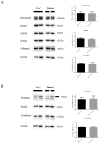Activated renal tubular Wnt/β-catenin signaling triggers renal inflammation during overload proteinuria
- PMID: 29605095
- PMCID: PMC5967994
- DOI: 10.1016/j.kint.2017.12.017
Activated renal tubular Wnt/β-catenin signaling triggers renal inflammation during overload proteinuria
Abstract
Imbalance of Wnt/β-catenin signaling in renal cells is associated with renal dysfunction, yet the precise mechanism is poorly understood. Previously we observed activated Wnt/β-catenin signaling in renal tubules during proteinuric nephropathy with an unknown net effect. Therefore, to identify the definitive role of tubular Wnt/β-catenin, we generated a novel transgenic "Tubcat" mouse conditionally expressing stabilized β-catenin specifically in renal tubules following tamoxifen administration. Four weeks after tamoxifen injection, uninephrectomized Tubcat mice displayed proteinuria and elevated blood urea nitrogen levels compared to non-transgenic mice, implying a detrimental effect of the activated signaling. This was associated with infiltration of the tubulointerstitium predominantly by M1 macrophages and overexpression of the inflammatory chemocytokines CCL-2 and RANTES. Induction of overload proteinuria by intraperitoneal injection of low-endotoxin bovine serum albumin following uninephrectomy for four weeks aggravated proteinuria and increased blood urea nitrogen levels to a significantly greater extent in Tubcat mice. Renal dysfunction correlated with the degree of M1 macrophage infiltration in the tubulointerstitium and renal cortical up-regulation of CCL-2, IL-17A, IL-1β, CXCL1, and ICAM-1. There was overexpression of cortical TLR-4 and NLRP-3 in Tubcat mice, independent of bovine serum albumin injection. Finally, there was no fibrosis, activation of epithelial-mesenchymal transition or non-canonical Wnt pathways observed in the kidneys of Tubcat mice. Thus, conditional activation of renal tubular Wnt/β-catenin signaling in a novel transgenic mouse model demonstrates that this pathway enhances intrarenal inflammation via the TLR-4/NLRP-3 inflammasome axis in overload proteinuria.
Keywords: Wnt/β-catenin; proteinuric nephropathy; renal inflammation.
Copyright © 2018 International Society of Nephrology. Published by Elsevier Inc. All rights reserved.
Figures











Similar articles
-
Downregulation of renal tubular Wnt/β-catenin signaling by Dickkopf-3 induces tubular cell death in proteinuric nephropathy.Cell Death Dis. 2016 Mar 24;7(3):e2155. doi: 10.1038/cddis.2016.62. Cell Death Dis. 2016. PMID: 27010856 Free PMC article.
-
Exosomal CCL2 from Tubular Epithelial Cells Is Critical for Albumin-Induced Tubulointerstitial Inflammation.J Am Soc Nephrol. 2018 Mar;29(3):919-935. doi: 10.1681/ASN.2017050523. Epub 2018 Jan 2. J Am Soc Nephrol. 2018. PMID: 29295871 Free PMC article.
-
Palmitate aggravates proteinuria-induced cell death and inflammation via CD36-inflammasome axis in the proximal tubular cells of obese mice.Am J Physiol Renal Physiol. 2018 Dec 1;315(6):F1720-F1731. doi: 10.1152/ajprenal.00536.2017. Epub 2018 Sep 19. Am J Physiol Renal Physiol. 2018. PMID: 30230367
-
Proteinuria: detection and role in native renal disease progression.Transplant Rev (Orlando). 2012 Jan;26(1):3-13. doi: 10.1016/j.trre.2011.10.002. Transplant Rev (Orlando). 2012. PMID: 22137726 Review.
-
Wnt/β-catenin signalling and podocyte dysfunction in proteinuric kidney disease.Nat Rev Nephrol. 2015 Sep;11(9):535-45. doi: 10.1038/nrneph.2015.88. Epub 2015 Jun 9. Nat Rev Nephrol. 2015. PMID: 26055352 Free PMC article. Review.
Cited by
-
Wingless-type MMTV integration site family member 5a: a novel biomarker regulated in type 2 diabetes mellitus and diabetic kidney disease.J Diabetes Metab Disord. 2019 Nov 22;18(2):525-532. doi: 10.1007/s40200-019-00461-8. eCollection 2019 Dec. J Diabetes Metab Disord. 2019. PMID: 31890678 Free PMC article.
-
A downstream molecule of 1,25-dihydroxyvitamin D3, alpha-1-acid glycoprotein, protects against mouse model of renal fibrosis.Sci Rep. 2018 Nov 26;8(1):17329. doi: 10.1038/s41598-018-35339-x. Sci Rep. 2018. PMID: 30478350 Free PMC article.
-
FGF1ΔHBS ameliorates chronic kidney disease via PI3K/AKT mediated suppression of oxidative stress and inflammation.Cell Death Dis. 2019 Jun 12;10(6):464. doi: 10.1038/s41419-019-1696-9. Cell Death Dis. 2019. PMID: 31189876 Free PMC article.
-
BMP7 ameliorates intervertebral disc degeneration in type 1 diabetic rats by inhibiting pyroptosis of nucleus pulposus cells and NLRP3 inflammasome activity.Mol Med. 2023 Mar 1;29(1):30. doi: 10.1186/s10020-023-00623-8. Mol Med. 2023. PMID: 36858954 Free PMC article.
-
Opposing actions of renal tubular- and myeloid-derived porcupine in obstruction-induced kidney fibrosis.Kidney Int. 2019 Dec;96(6):1308-1319. doi: 10.1016/j.kint.2019.06.020. Epub 2019 Jul 31. Kidney Int. 2019. PMID: 31585741 Free PMC article.
References
Publication types
MeSH terms
Substances
Grants and funding
LinkOut - more resources
Full Text Sources
Other Literature Sources
Miscellaneous

